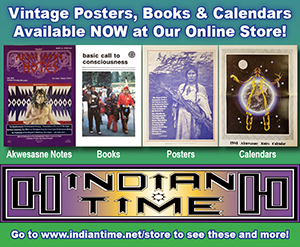Honor past princesses, but retire the 'Indian Princess'
My near-princess experience and my hope to elevate Native women’s contributions and achievements
By Yanenowi Logan. Seneca Nation of Indians and New York State Fair Indian Village Princess.
An annual highlight of Labor Day weekend at the New York State Fair is Native American Day - we Natives call it “Ind’n Day.” Natives come from across the state and converge on the Indian Village, where the Six Nations are represented in bark-covered stands and sell their wares.
A group of singers and dancers perform daily on an elevated stage in the shape of a turtle, the Turtle Mound, and share the culture and history of the people Indigenous to the state. Each year there is an Indian Princess selected to represent one of the territories; each nation gets a turn on a rotating basis. This year it was the Seneca Nation Cattaraugus Territory’s selection. The Agricultural Society selected me.
A Facebook post urging the young women of Cattaraugus to apply circulated and a couple of friends and my auntie forwarded the post to me. I decided almost immediately to apply. After submitting a letter of intent, I was invited to interview; most questions were based on my comprehension of our culture.
After the interview, I was nervous and unsure. Nervous, because I thought my answers weren’t Seneca enough. Was my storytelling up to par? Did I demonstrate knowledge of my culture and show I’m proud of it? Did I convey confidence and my desire to serve in a position that young women like my younger self would look up to? That same night I was informed that I was selected as this year’s princess and I was beside myself with excitement.
I was especially thrilled since I come from a long line of Logans with a strong, historic presence in the Indian Village. My grandfather and great-grandfather occupied the Tonawanda stand for years; my great-aunt, great-grandmother, and great-great-grandmother all sat in the women’s building beading daisy chains and earrings. I was so looking forward to being there and sharing in the tradition.
And then the Delta variant hit. Despite being vaccinated, I tested positive, got breakthrough COVID-19, and was ordered to a 10-day quarantine. My princess “reign” and my State Fair Indian Village experience derailed. Even though I now sit in isolation - doing my classes online and attending conferences through Zoom and missing out on the Fair - I believe I was selected to represent. So, this is my shot.
By virtue of being granted the privilege comes with it a responsibility to honor and respect past princesses, but also to lead and be a positive role model for young Native women. It is in this vein that I strive to use this platform to propose the retirement of the Indian Princess title in lieu of a more culturally appropriate way to celebrate and honor young Indigenous women
I don’t want to dishonor or disrespect past princesses but bring us forward with more culturally relevant and accurate nomenclature.
There are better ways of showcasing our strong women to the world. The Haudenosaunee, people of the Longhouse, are matrilineal people. Lineage and clans are passed down from the women and clan mothers determine our traditional leaders.
I understand what it means to have strong women lead and represent, and I want to contribute in my own way. Being called an Indian Princess, although a position of honor, can also be uncomfortable in predominately white spaces.
I had the awkward experience of being called princess all day at work this summer by my white colleagues once I shared the news. Although I know their congratulations were well-intentioned, I couldn’t help but feel tokenized. I knew that I was the only Native girl they knew and now they could tell their friends and families that they knew a real Indian Princess.
The issue isn’t just a matter of discomfort with the term but the stereotypes, microaggressions and historical inaccuracies embedded in it.
All over Indian Country, at community events, powwows, and fairs, such as Crow Fair in Montana, the idea of Indian royalty and the practice of naming princesses has been pervasive.
However, the notion of an Indian princess was not part of Native culture or tradition — it was an idea, however flawed or well-intentioned, that was adopted and became a mainstay at events.
The New York State Fair Indian Village has its own history in embracing royalty into its traditions. In 1952, 69 years ago, the New York State Fair installed its first Indian Princess: Frieda Williams, Tuscarora.
Maribel Watt, Seneca (Allegany) was the second New York State Fair Indian Princess in 1953.
Maribel served twice as the clerk of the Seneca Nation and was elected to council; she was instrumental on several committees during the removal period post-Kinzua when Senecas were dispossessed of land on the Allegany territory due to the building of the Kinzua Dam when hundreds were devastated by the loss of their dwellings and homelands.
She was the epitome of strong leadership and all that we should celebrate and honor in past princesses. She passed in 2015. It is time to recognize and celebrate women, such as Maribel Watt, who are reflective of who we are and do so in ways that empower us.
I am familiar with and look up to powerful Indigenous women. Women like environmental activist Winona LaDuke, Anishinaabe, who has been an incredible inspiration in my journey in studying environment and sustainability at Cornell University.
Women like Eloise Cobell, Blackfeet, who spent decades fighting the federal government to address and settle the precedent-setting Trust Funds case; Louise Erdrich, Turtle Mountain Chippewa, prolific writer, author, and Pulitzer Prize-winner; Deb Haaland, Laguna Pueblo, congresswoman and first Native Secretary of the Interior; and strong, beloved clan mothers throughout the confederacy such as Audrey Shenandoah, Onondaga, and my great-grandmother Arlene Logan, Seneca, those old school elders who seemed to possess inherent wisdom, knowledge, and insights who could light up rooms with their mere entry, and too many others to list here.
These women and so many others have paved a path for Indigenous women for generations to come. They should be celebrated and more widely recognized.
I accepted the title and the honor of the Indian Princess so that I might reject the title of the Indian Princess. I propose a more accurate representation of Native women and suggest that we put an end to the Indian Princess era. I am also launching a fundraiser to commission a new sash for next year’s Miss Haudenosaunee. This is an opportunity to embark on a new path and a new way to honor our strong, up and coming, young Native women.
I honor all past Indian Princesses and their life-long accomplishments and contributions to our communities. I wish I had the opportunity to wear the sash, climb the Turtle Mound and represent in person at the New York State Fair.
But I will use my voice to ensure that Ongwehonwe women stand tall and are recognized for who they really are.
We remain rooted in culture and traditions that are ours; we must peel away the false pretenses of Indian Princess nomenclature. We have no need for notions of a Disney-fied, romanticized, abstract Princess ideal.
We have a great need for Haudenosaunee role models with resonant voices, community roots, and traditional values, yet with forward-thinking leadership qualities and convictions.
I ask not only my Seneca relations, but my Six Nations peers and all Indigenous women to join me in pressing for change. Out with the Indian Princess, on with Ongwehoweh, Haudenosaunee!
This essay does not necessarily reflect the view of Indian Country Today; voices in our opinion section represent a variety of reader points of view. If you would like to contribute an essay to Indian Country Today, email the opinion editor, Vincent Schilling at opinion@indiancountrytoday.com. Reprinted with permission from Indian Country Today.








Reader Comments(0)